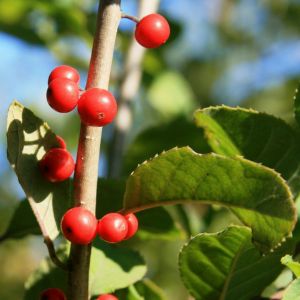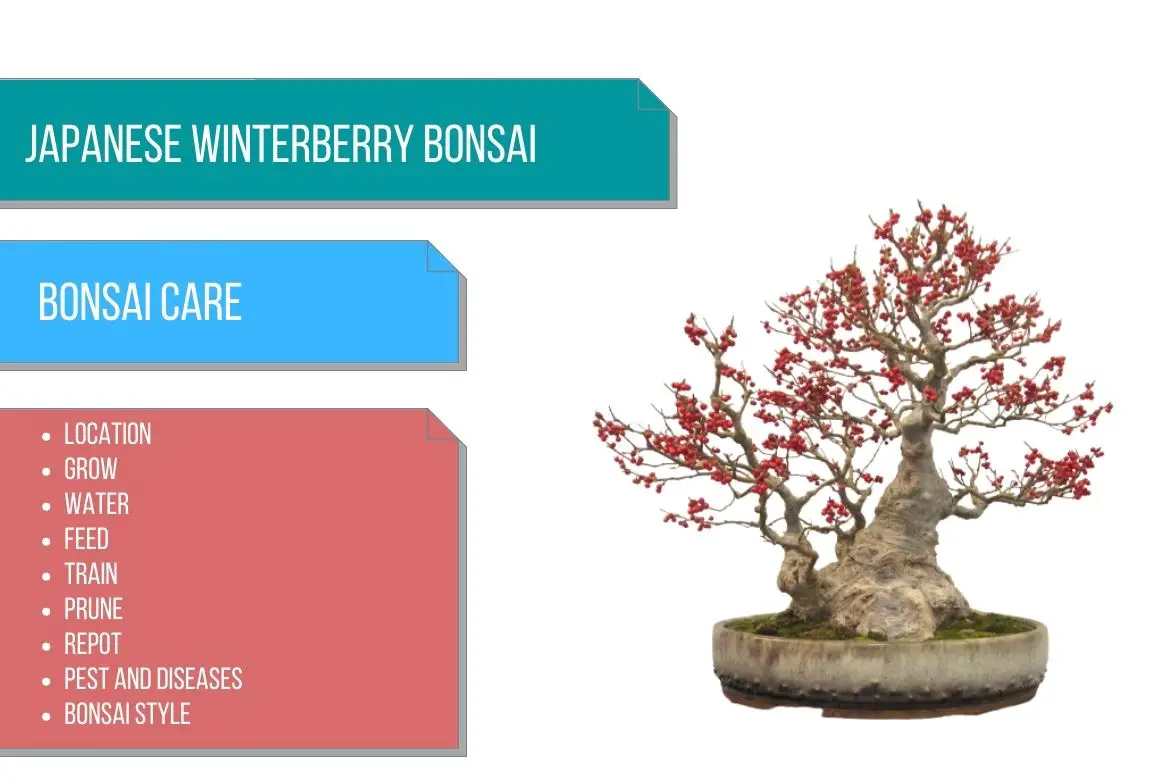
Japanese winterberry
(Ilex serrata)
Country of Origin : Japan and China
Bonsai Styles : Informal upright, cascade
Zone : 6 – 9
Japanese winterberry, aka ‘Japanese deciduous holly‘, is a half-hardy tree and indigenous to northern hemisphere.
Ilex serrata, a native of Japan, makes a beautiful bonsai subject.
Compared to the glossy, spiny evergreen foliage of the Ilex Aquifolium (common holly, European holly), the thin, serrated leaves of the Japanese deciduous holly appear closer to a cherry or apple leaf.
The bright red berries of this deciduous holly are its most notable feature. These berries emerge from small pink flowers. Its small, oval, pointed leaves turn yellow and then to shades or red and purple in fall.
Fall and winter are two of its best seasons, when the light gray bark and bright red berries create an attractive sight.

Important : In order to produce berries, a female bonsai tree form must be grown, and a male tree is needed to pollinate the female. The male tree need not be a bonsai. Male tree can be planted as a garden shrub.
Red berries of Japanese deciduous holly tree. These berries stay on the tree even after all the leaves have fallen. Creating a spectacular bonsai specimen.
Image source : wikimedia.org
There is another Japanese holly bonsai variety called Ilex crenata. Both the varieties – Ilex crenata and Ilex serrata are called holly trees. However, both of them are completely different. Ilex crenata is evergreen whereas Ilex serrata is deciduous. Both of them are very different in appearance also. (Important piece of information to have when making a bonsai purchase)
Varieties of Ilex serrata used for making a bonsai tree :
- Ilex serrata ‘Leucocarpa’ : This variety produces white colored berry instead of red berries. It is sometimes used to make bonsai in Japan.
- Ilex serrata ‘Subtilis’ : This is a dwarf variety of Japanese deciduous holly tree and is an excellent choice for small bonsai. Also, this variety is a hermaphrodite. hence, does not need a male pollinator tree to produce berries.
Unlike Japanese evergreen holly bonsai tree, Japanese deciduous holly bonsai tree prefer being out in the sun.
Best location to keep Japanese winterberry Bonsai
The Japanese deciduous holly bonsai should be kept in full sun in summer and fall.
This tree is not hardy to zone 7 and 8 the bonsai pot and must be kept in shelter (a shed or greenhouse) to protect it from frost in spring and winter.
Refer sunlight requirements for indoor plants for more indoor gardening ideas. Also, refer to do bonsai trees need sunlight for more indoor and outdoor bonsai location ideas.
Propagation of Japanese winterberry
Japanese winterberry tree can be propagated by air layering in spring.
It can also be propagated by using stratified seeds in the months of early spring. However, most of the seedlings will be male and hence wont be able to produce berries.
Softwood cuttings can be used to propagate the tree in summer or spring.
Watering Japanese winterberry Bonsai
In the growing season, it is very important that these plants receive regular watering.
Even briefly allowing the rootball to dry out will lead to the tree’s death.
Maintain just a slight moisture level in the bonsai soil in winter and spring. Failure to do this will lead to dropping of the red berries.
Wiring Japanese winterberry Bonsai
Wiring can be done in midsummer.
Unlike Japanese evergreen holly bonsai (where the wires can be left for almost 2 years), Japanese winterberry bonsai (Japanese deciduous holly) should not be left with wires for more than a year.
Pruning Japanese winterberry Bonsai
When to prune Japanese winterberry bonsai?
How to prune Japanese winterberry bonsai?
Maintain a plant’s overall shape and bonsai style by pruning any long new shoots in early summer (when they are still tender) and again in fall. Keep the pruning in the fall to a minimum.
Prune shoots back to two or three leaves.
Flower buds of the next year will develop on the current season’s shoots, so take care not to remove the potential shoots which will bear those blossoms.
Pinching Japanese winterberry Bonsai
Some of the buds should be pinched out when they form, but others should be left until the leaves have hardened.
Repotting Japanese winterberry Bonsai
When to repot Japanese winterberry bonsai?
While the Japanese winterberry bonsai tree is still young, repot the bonsai tree every year.
However, when the bonsai tree reaches an age of almost 10 years, repotting can be done every two to three years.
Early spring is a goo time to repot Japanese winterberry bonsai.
You can use a basic bonsai soil mix as a potting soil.
OR
You can also use a bonsai soil which is a mix of loam, sharp sand and peat in the ratio of 1:1. Instead of peat you can also use garden compost in this bonsai soil mix.
Must Read: Bonsai Soil Recipes
Must read : Choosing the right bonsai container
Feeding Japanese winterberry Bonsai
Apply a balanced feed (or general fertilizer) every two weeks throughout the growing season.
Low-nitrogen fertilizer will be beneficial to the bonsai tree when applied in late summer.
Diseases and pest of Japanese winterberry Bonsai
Young shoots are sometimes attacked by aphids, but these can usually be controlled manually. If the problem persists, consider using a systemic insecticide.
Japanese winterberry bonsai care
Japanese winterberry tree can tolerate frost to some extent. However, when planted in a bonsai container, keep the bonsai tree protected from low temperatures.
As Japanese winterberry bonsai trees are primarily grown for their attractive berries, make sure that your bonsai tree has a source from where it can get pollinated.
In case you do not have access to a male bonsai plant, you can try keeping your female bonsai tree in proximity of an ordinary Japanese holly tree. The probability of your bonsai tree pollinating and producing berries will increase.
Birds are also attracted to the red berries of the tree. If the bonsai tree is placed outside, try to keep it in a space where birds can not infiltrate. You can also use some kind of cage to protect the berries from birds.
What to look for when buying Japanese winterberry Bonsai
Before buying Japanese winterberry Bonsai tree, make sure that the tree is a female. You can even ask the owner or the staff of the nursery to be sure.


